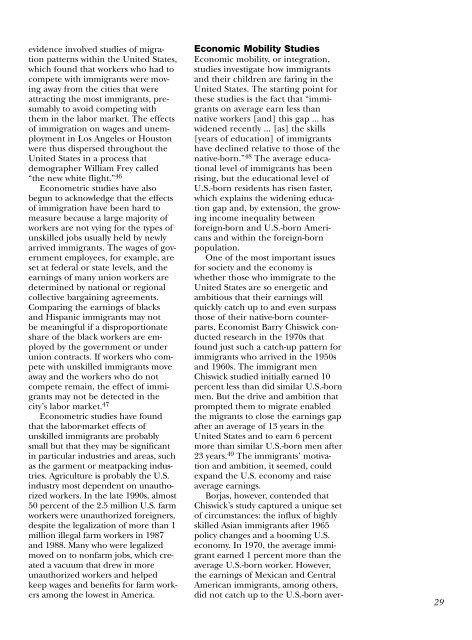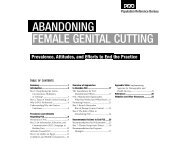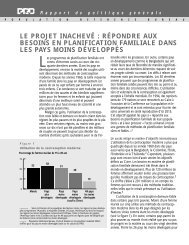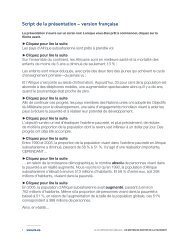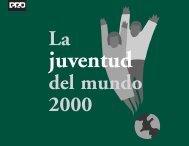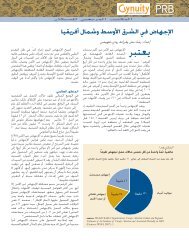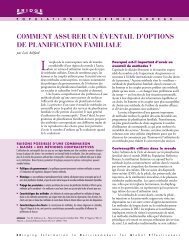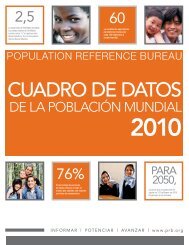Immigration Shaping America - Population Reference Bureau
Immigration Shaping America - Population Reference Bureau
Immigration Shaping America - Population Reference Bureau
You also want an ePaper? Increase the reach of your titles
YUMPU automatically turns print PDFs into web optimized ePapers that Google loves.
evidence involved studies of migration<br />
patterns within the United States,<br />
which found that workers who had to<br />
compete with immigrants were moving<br />
away from the cities that were<br />
attracting the most immigrants, presumably<br />
to avoid competing with<br />
them in the labor market. The effects<br />
of immigration on wages and unemployment<br />
in Los Angeles or Houston<br />
were thus dispersed throughout the<br />
United States in a process that<br />
demographer William Frey called<br />
“the new white flight.” 46<br />
Econometric studies have also<br />
begun to acknowledge that the effects<br />
of immigration have been hard to<br />
measure because a large majority of<br />
workers are not vying for the types of<br />
unskilled jobs usually held by newly<br />
arrived immigrants. The wages of government<br />
employees, for example, are<br />
set at federal or state levels, and the<br />
earnings of many union workers are<br />
determined by national or regional<br />
collective bargaining agreements.<br />
Comparing the earnings of blacks<br />
and Hispanic immigrants may not<br />
be meaningful if a disproportionate<br />
share of the black workers are employed<br />
by the government or under<br />
union contracts. If workers who compete<br />
with unskilled immigrants move<br />
away and the workers who do not<br />
compete remain, the effect of immigrants<br />
may not be detected in the<br />
city’s labor market. 47<br />
Econometric studies have found<br />
that the labor-market effects of<br />
unskilled immigrants are probably<br />
small but that they may be significant<br />
in particular industries and areas, such<br />
as the garment or meatpacking industries.<br />
Agriculture is probably the U.S.<br />
industry most dependent on unauthorized<br />
workers. In the late 1990s, almost<br />
50 percent of the 2.5 million U.S. farm<br />
workers were unauthorized foreigners,<br />
despite the legalization of more than 1<br />
million illegal farm workers in 1987<br />
and 1988. Many who were legalized<br />
moved on to nonfarm jobs, which created<br />
a vacuum that drew in more<br />
unauthorized workers and helped<br />
keep wages and benefits for farm workers<br />
among the lowest in <strong>America</strong>.<br />
Economic Mobility Studies<br />
Economic mobility, or integration,<br />
studies investigate how immigrants<br />
and their children are faring in the<br />
United States. The starting point for<br />
these studies is the fact that “immigrants<br />
on average earn less than<br />
native workers [and] this gap ... has<br />
widened recently ... [as] the skills<br />
[years of education] of immigrants<br />
have declined relative to those of the<br />
native-born.” 48 The average educational<br />
level of immigrants has been<br />
rising, but the educational level of<br />
U.S.-born residents has risen faster,<br />
which explains the widening education<br />
gap and, by extension, the growing<br />
income inequality between<br />
foreign-born and U.S.-born <strong>America</strong>ns<br />
and within the foreign-born<br />
population.<br />
One of the most important issues<br />
for society and the economy is<br />
whether those who immigrate to the<br />
United States are so energetic and<br />
ambitious that their earnings will<br />
quickly catch up to and even surpass<br />
those of their native-born counterparts.<br />
Economist Barry Chiswick conducted<br />
research in the 1970s that<br />
found just such a catch-up pattern for<br />
immigrants who arrived in the 1950s<br />
and 1960s. The immigrant men<br />
Chiswick studied initially earned 10<br />
percent less than did similar U.S.-born<br />
men. But the drive and ambition that<br />
prompted them to migrate enabled<br />
the migrants to close the earnings gap<br />
after an average of 13 years in the<br />
United States and to earn 6 percent<br />
more than similar U.S.-born men after<br />
23 years. 49 The immigrants’ motivation<br />
and ambition, it seemed, could<br />
expand the U.S. economy and raise<br />
average earnings.<br />
Borjas, however, contended that<br />
Chiswick’s study captured a unique set<br />
of circumstances: the influx of highly<br />
skilled Asian immigrants after 1965<br />
policy changes and a booming U.S.<br />
economy. In 1970, the average immigrant<br />
earned 1 percent more than the<br />
average U.S.-born worker. However,<br />
the earnings of Mexican and Central<br />
<strong>America</strong>n immigrants, among others,<br />
did not catch up to the U.S.-born aver-<br />
29


